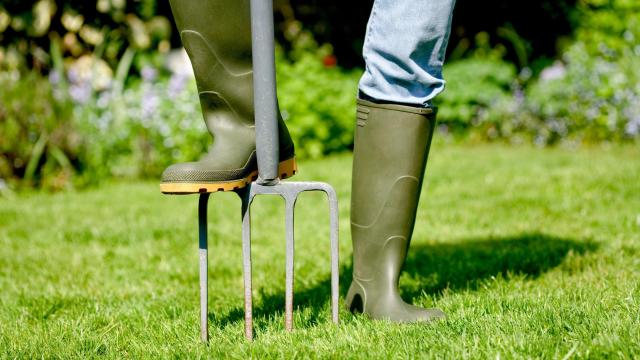Depending on where you live — and your mentality about yard appearance — lawns can be hard work. If you don’t want to go the artificial route (which has its own environmental and physical challenges), there are other ways to make lighter work of lawn care. There are lots of little steps you can take to keep your lawn lush and green or to conserve water — and one way to help encourage lawn growth and lighten your landscaping load is to aerate the grass.
Here’s what aeration is, and why you should be poking holes in your yard.
What is aeration?
Grass can grow deep, healthy roots, but sometimes it needs a little help. Aeration is the process of punching holes in the lawn for water and nutrients to penetrate deeper into the soil and fortify the roots. When you have well-fed and hydrated roots, they grow deeper, letting the grass stay green longer — not to mention thicker and more sustainable. You won’t need to water or fertilize nearly as much as you normally would if a lawn is sufficiently aerated.
When to aerate your lawn
Landscaping company Briggs & Stratton explains that aeration helps with stunted grass growth, which is compacted soil: “Compacted soils have too many solid particles in a certain volume or space, which prevents proper circulation of air, water, and nutrients within the soil.” Heavy amounts of thatch (tightly intermingled layer of organic debris, such as living and dead stems, leaves, and roots, that accumulates where the grass stems meet the soil) can add to a compacted lawn.
According to lawn care site Trees.com, once you have half an inch or more of thatch, it’s probably time remove it and aerate your yard. Aeration might also be beneficial when your lawn is quick to dry out, because water may not be penetrating deep enough. If you just bought a new construction home, the soil may be compacted due to construction, or if your lawn sustains heavy traffic, that can compress the soil and keep it from growing.
How to aerate your lawn
First, you need to prep the lawn. Remove the layer of thatch so the aeration tools can puncture through the soil properly. After removing thatch, True Green suggests watering your lawn a few days ahead of aeration. Watering one inch into the soil allows for easier penetration. Then choose the type of aeration you would like, be it spike or plug. Spike aeration is the act of poking holes in the yard, which can be done with aeration shoes, manual push or hand aerators, and electric aerators.
Plug aeration involves hollow spikes punching the soil and removing a chunk of the earth. This process creates a broader hole for optimal aeration. Whichever version you choose, make sure you cover the entire lawn in one direction. Home Depot suggests going over the yard again in a perpendicular motion. After this process is done, you should probably fertilize or add a layer of compost (but it’s not required). Be sure to water your lawn two or three times a week for the next few weeks to strengthen the roots.

Leave a Reply
You must be logged in to post a comment.